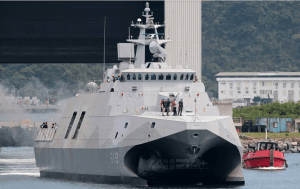Taiwanese President Tsai Ing-wen faces five security challenges that will test the depth of her political capital and possibly pit Taiwan’s military concerns against popular ones.
These challenges include increasing the country’s self-sufficiency in weapons, strengthening popular support for the military, financing the defense budget and maintaining the will to fight through a credible defense strategy.
During her second term (2020 to the present), Tsai has sought to raise the morale of the military by frequently visiting military bases and observing military exercises. She increased the military budget to finance better military housing, educational opportunities and pay for soldiers.
According to Taiwan’s Ministry of National Defense (MND), 7,800 Taiwanese indigenous peoples serve in the military, constituting 28 out of every 1,000 in the Taiwan military — disproportionately higher than their representation in Taiwan’s general population.
Women constitute 15% of Taiwan’s military. Tsai promoted the first indigenous person and the first woman to the rank of general.
The military’s morale and sense of professionalism are impaired by Taiwan’s dependence on antiquated military hardware and weapons systems procured from other countries. When Taiwan procured Apache helicopters from the United States in 2011, those who flew them in 2013 were proud to show them off.
To increase national defense self-sufficiency and self-reliance, Tsai embarked on a plan for national defense manufacturing. A new jet trainer, the Brave Eagle, has been developed. Mass production will start in 2023 with a production target of 66 aircraft.
That could ramp up Taiwan’s ability to build a second indigenous combat aircraft to take the place of the aging Dassault Mirages procured from France in the 1990s.
Tsai also created a naval ship-building program focussed on developing several classes of vessels. Used by the Taiwan navy and coast guard, the multi-mission Tuo Chiang-class corvette combines high speed (44 knots) with the ability to accommodate different weapons systems.

To assist in amphibious operations and resupply, Taiwan built the landing platform dock, Yu Shan, in June 2020 and launched two new minelaying ships in January 2022.
Previous Taiwan administrations said they would build an indigenous submarine, but Tsai managed to break through the inertia. A prototype is scheduled to be completed by October 2022. If the prototype passes all of its sea trials, the MND hierarchy supports building seven additional submarines.
The Executive Yuan (Taiwan’s executive branch of government) is putting together a special budget of US$10 billion to finance the construction of additional boats. Tsai has also developed a wide array of missiles and is ramping up missile production to ensure Taiwan has an adequate supply if China invades.
Tsai needs to continue her efforts to build popular support for the military. As upbeat as the defense production situation might be, the martial law (1949–1987) era casts a long shadow over the Taiwan military.
During this era, the defense budget consumed a near majority of the national budget and blocked the introduction of additional health and social benefits. The Taiwan Garrison Command — an army-affiliated organization akin to Nazi Germany’s Gestapo or wartime Japan’s Kempeitai — became the dreaded heel of dictatorship.
Despite this history, the Russian invasion of Ukraine created a sea change in attitude among the Taiwanese public. According to a Taiwanese Public Opinion Foundation (TPOF) poll conducted in March 2022, 76% support extending compulsory military service to at least one year.
Taiwan’s previous administration changed the requirement from one year to only four months of training. The MND could reinstate the one-year conscription period without changing the law.
Given that Tsai’s political base is primarily young people whose support for the Democratic Progressive Party (DPP) is counting on the party’s success in the November 26 “nine-in-one elections”, any extension of the conscription period will not take place until early 2023.
Taiwan’s reserve force capability has long been a US concern when it comes to the defense of Taiwan. To this end, the MND created a new reserve command and has started more frequent combat readiness training. The Tsai administration has also increased the defense budget after yielding to US pressure. The 2023 defense budget is US$13.75 billion (2.4% of GDP) — without factoring in special defense budgets.
To ensure further defense strengthening, Tsai needs to allocate more funds for extended periods of conscription and additional reserve training. While a majority of Taiwanese support extending the period of conscription and see the need for added reserve training, 66% are opposed to increasing taxes to pay for additional defense expenditures.
Still, polling in March 2022 found that 73% of Taiwanese people would be willing to fight if Taiwan was invaded. In the case of an invasion by China in which the United States did not send troops, 65% of the population had confidence in the nation’s defense and were willing to fight.

This polling result was a huge improvement on the 2020 poll in which 60% of respondents believed the Taiwanese military would not be able to defend Taiwan on its own.
Whether these polls are durable remains to be seen, as Taiwan lacks a coherent national defense strategy combining asymmetric and traditional warfare. Another concern is determining whether the end goal of funding, staffing and producing weapons for the military is to defend Taiwan or seek Taiwanese independence.
If there is no clear strategy, the country’s will to fight could be impaired.
Bill Sharp is an independent researcher based in Honolulu. He previously taught East Asian Politics at Chaminade University of Honolulu, Hawaii Pacific University, and the University of Hawaii, Manoa.
This article, republished with permission, was first published by East Asia Forum, which is based out of the Crawford School of Public Policy within the College of Asia and the Pacific at the Australian National University.

